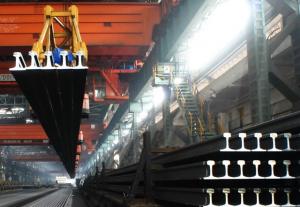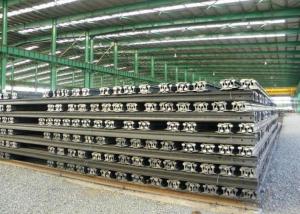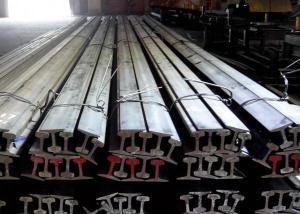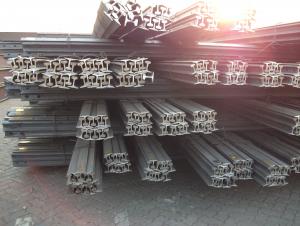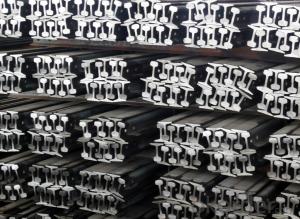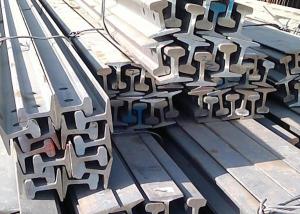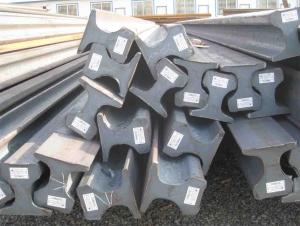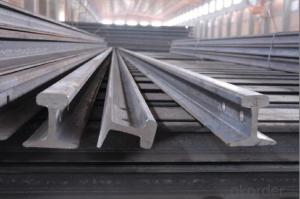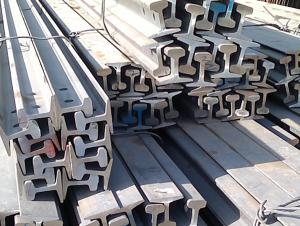Light Steel Rail GB 9kg GB12kg GB15kg with High Quality
- Loading Port:
- China main port
- Payment Terms:
- TT or LC
- Min Order Qty:
- 25 m.t.
- Supply Capability:
- 100000 m.t./month
OKorder Service Pledge
OKorder Financial Service
You Might Also Like
Product Description of Light Steel Rail GB 9kg GB12kg GB15kg with High Quality:
Sizes: 38kg, 43kg, 45kg, 50kg, 60kg.
Production Standard: GB2585-81, DIN, AREMA, JIS, BS, UIC, etc.
Material: 50MN, U71MN, 900A, 110A, etc.
Length: 6m-25m according to the requriements of the clients
Alloy No | Grade | Element(%) | ||||
C | Mn | S | P | Si | ||
Q235 | B | 0.12—0.20 | 0.3—0.7 | ≤0.045 | ≤0.045 | ≤0.3 |
Usages of Light Steel Rail GB 9kg GB12kg GB15kg with High Quality:
Light rail is mainly used in forest region, mines, factories and construction sites laid of the place such as temporary transport line and light motorcycles with line. Be widely used for railway, subway, transportation track, express, curve way, tunnel way and so on.
Packaging & Delivery of Light Steel Rail GB 9kg GB12kg GB15kg with High Quality:
1. Packing: it is nude packed in bundles by steel wire rod
2. Bundle weight: not more than 3.5MT for bulk vessel; less than 3 MT for container load
3. Marks:
Color marking: There will be color marking on both end of the bundle for the cargo delivered by bulk vessel. That makes it easily to distinguish at the destination port.
Tag mark: there will be tag mark tied up on the bundles. The information usually including supplier logo and name, product name, made in China, shipping marks and other information request by the customer.
If loading by container the marking is not needed, but we will prepare it as customer request.
4. Transportation: the goods are delivered by truck from mill to loading port, the maximum quantity can be loaded is around 40MTs by each truck. If the order quantity cannot reach the full truck loaded, the transportation cost per ton will be little higher than full load.
5. Delivered by container or bulk vessel
6. Delivery Time: All the Hot Rolled Steel Rail will be transpoted at the port of Tianjin, China within 30 days after receiving the advance payment by T/T or the orginal L/C at sight.
Inspection of Light Steel Rail GB 9kg GB12kg GB15kg with High Quality:
We will send the MTC of the factory to the clients dirrectly which contain the anlisis of the heat, chemiqul composition, phisical characteristicas, etc.
And our inspectors will arrive at the factory to meke the inspection of the size, length, weight and quantity before the transportation from the factory.
FAQ:
Q1: How soon can we receive the product after purchase?
A1: Within three days of placing an order, we will begin production. The specific shipping date is dependent upon international and government factors, but is typically 7 to 10 workdays.
Q2: Can stainless steel rust?
A2: Stainless does not "rust" as you think of regular steel rusting with a red oxide on the surface that flakes off. If you see red rust it is probably due to some iron particles that have contaminated the surface of the stainless steel and it is these iron particles that are rusting. Look at the source of the rusting and see if you can remove it from the surface.
Q3: Why buy Materials & Equipment from OKorder.com?
A3: All products offered by OKorder.com are carefully selected from China's most reliable manufacturing enterprises. Through its ISO certifications, OKorder.com adheres to the highest standards and a commitment to supply chain safety and customer satisfaction.
Images:

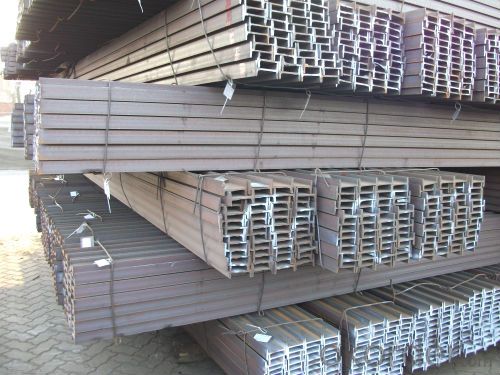
- Q:Can steel rails be used for heritage or tourist railways?
- Yes, steel rails can be used for heritage or tourist railways. In fact, steel rails are commonly used in both modern and historical railway systems due to their durability, strength, and cost-effectiveness. They provide a safe and reliable infrastructure for trains to run on, ensuring a smooth and efficient operation for heritage or tourist railways.
- Q:What are the pros and cons of using steel rails in railway construction?
- Pros of using steel rails in railway construction include: 1. Durability: Steel rails have a high level of durability, able to withstand heavy loads and extreme weather conditions. This makes them ideal for long-term use in railway construction. 2. Strength: Steel rails have excellent strength-to-weight ratio, providing the necessary support and stability for trains to travel at high speeds. 3. Smooth ride: Steel rails offer a smooth and consistent surface for trains to travel on, reducing vibrations and ensuring a comfortable ride for passengers. 4. Low maintenance: Compared to other rail materials, steel rails require relatively low maintenance. They have a longer lifespan and are less prone to wear and tear, reducing the need for frequent replacements or repairs. 5. Versatility: Steel rails can be easily modified and adapted to different track configurations, making them suitable for various railway designs and layouts. Cons of using steel rails in railway construction include: 1. Cost: Steel rails can be more expensive to manufacture and install compared to other rail materials such as concrete or wood. This can add to the overall construction costs of a railway project. 2. Corrosion: Steel is prone to corrosion, especially in humid or coastal environments. Regular maintenance and protective coatings are required to prevent rust formation and ensure the longevity of steel rails. 3. Noise pollution: Steel rails can generate noise when trains pass over them, particularly at higher speeds. This can be a concern for nearby residents and requires additional noise reduction measures, such as installing sound barriers or using noise-dampening track components. 4. Weight limitations: While steel rails are strong, there are weight limitations to consider. Extremely heavy loads or concentrated loads can cause deformation or damage to the rails, necessitating careful planning and monitoring of freight transport. 5. Environmental impact: Steel production has significant environmental implications, including greenhouse gas emissions and energy consumption. The use of steel rails contributes to these impacts, although efforts are being made to develop more sustainable and eco-friendly production processes.
- Q:What is the lifespan of steel rails in highly used rail lines?
- The lifespan of steel rails in highly used rail lines can vary depending on various factors such as maintenance practices, traffic volume, and environmental conditions. However, with proper maintenance and regular inspections, steel rails can typically last anywhere from 30 to 40 years or even longer.
- Q:What is the impact of steel rails on ride comfort?
- Ride comfort in various transportation systems, particularly in railways, is greatly influenced by steel rails. The utilization of steel rails ensures a stable and smooth track surface, resulting in a more comfortable experience for passengers. The ability of steel rails to evenly distribute the weight of the train is one of its main advantages, as it minimizes vibrations and decreases the impact of jolts and bumps on passengers. This even weight distribution is crucial in maintaining a comfortable ride, especially when faced with sudden changes in the track's surface, such as joints or unevenness. Furthermore, steel rails possess superior durability and strength compared to other rail materials. This characteristic makes them less susceptible to deformations or warping, guaranteeing a consistent and reliable surface for train travel. The stability provided by steel rails further contributes to a smoother ride by minimizing lateral movements or swaying that may cause discomfort. Another factor that improves ride comfort is the precision and accuracy with which steel rails are manufactured and installed. The rails are meticulously aligned and joined together to create a seamless track, minimizing any potential disruptions that could affect the quality of the ride. This attention to detail ensures that trains glide smoothly along the track, enhancing overall comfort for passengers. Additionally, steel rails also aid in reducing noise levels during train travel. The firmness and stability of steel rails help to dampen and absorb vibrations, resulting in quieter rides. This reduction in noise pollution contributes to a more pleasant and serene journey for passengers. In summary, steel rails have a significant impact on ride comfort in transportation systems. They provide a stable, smooth, and durable surface for trains to travel on, minimizing vibrations, jolts, and bumps. The precision and accuracy of steel rail installation further enhance ride quality, while their ability to dampen noise levels creates a more peaceful experience for passengers. Overall, the use of steel rails greatly contributes to a more comfortable and enjoyable journey.
- Q:How are steel rails protected from damage caused by rockslides?
- To protect steel rails from damage caused by rockslides, a combination of active and passive measures is implemented. Firstly, regular inspections and maintenance of the rail lines are conducted to identify and remove loose rocks or debris that could trigger a rockslide. This proactive approach effectively prevents rockslides from happening. Additionally, passive protective measures are employed. One common method involves installing rockfall protection barriers or fences along the rail lines. These barriers are made of strong materials like steel or concrete and are designed to absorb the impact of falling rocks, preventing them from reaching the tracks. Engineers in rockslide-prone areas also employ slope stabilization techniques such as rock bolting, meshing, or shotcreting. These methods secure loose rocks and prevent them from dislodging and falling onto the tracks. Strategically placed rockfall catchment areas or ditches are another approach to minimize damage. These areas collect and divert falling rocks away from the tracks, reducing the risk of harm. Moreover, advanced technologies like ground monitoring systems are increasingly utilized. These systems constantly monitor ground conditions using sensors and geotechnical instruments, providing real-time detection of potential rockslide hazards. Early warnings allow railway operators to take immediate action, such as temporarily halting train operations or implementing speed restrictions, ensuring track safety and preventing damage. Overall, a combination of active maintenance, passive protective measures, slope stabilization techniques, and advanced technologies safeguard steel rails from rockslide damage. These measures are essential for maintaining the integrity and safety of railway lines, minimizing the risk of accidents and disruptions caused by rockslides.
- Q:Can steel rails be used in railway systems with high-speed curves?
- Yes, steel rails can be used in railway systems with high-speed curves. Steel is a common material used for railway tracks due to its durability, strength, and ability to withstand heavy loads. Steel rails are designed to provide stability and support to train wheels, allowing them to navigate through curves at high speeds safely. Additionally, steel rails are resistant to wear and tear, which is crucial in high-speed operations where trains exert significant forces on the tracks. However, it is worth noting that certain modifications and design considerations may be necessary to ensure proper alignment and reduce the risk of derailment in high-speed curves.
- Q:How are steel rails protected against track settlement?
- Steel rails are protected against track settlement through various methods. One of the most common methods is the use of ballast, which is a layer of crushed stones or gravel that is laid beneath and around the rails. The ballast provides stability and helps distribute the weight of the trains evenly, preventing excessive settlement. Additionally, the rails are designed to be rigid and durable, with proper spacing and alignment. This ensures that the weight of the trains is evenly distributed along the length of the rails, reducing the risk of settlement. The rails are also regularly inspected and maintained to identify any signs of settlement or deformation. In some cases, engineers may use techniques such as under-sleeper pads or resilient fasteners to further protect against settlement. Under-sleeper pads are rubber or polyurethane pads placed between the rail and the sleeper, which help absorb vibrations and reduce the impact of settlement. Resilient fasteners, on the other hand, are designed to allow some movement of the rail, compensating for settlement and reducing stress on the track structure. Overall, a combination of proper design, regular maintenance, and the use of ballast, under-sleeper pads, and resilient fasteners help protect steel rails against track settlement. These measures ensure the safety and stability of the tracks, minimizing the risk of derailments and ensuring smooth and efficient rail operations.
- Q:What are the main types of steel rails?
- The main types of steel rails are classified into three categories: light rails, heavy rails, and crane rails. Light rails are typically used in light-duty applications such as tramways and light industrial tracks. Heavy rails, on the other hand, are used for heavy-duty applications like mainline railways and high-speed tracks. Crane rails are specifically designed to withstand the heavy loads and constant movement of cranes in industrial environments.
- Q:What are the different types of rail sleepers used with steel rails?
- There exist various rail sleepers utilized alongside steel rails, each possessing unique characteristics and advantages. 1. Wooden Sleepers: Known as timber sleepers, wooden sleepers have enjoyed widespread usage in rail construction for numerous years. Crafted from treated hardwood or softwood, they offer commendable insulation and resistance to decay. Wooden sleepers are relatively cost-effective and simple to install, making them a favored option in many railway systems. 2. Concrete Sleepers: Also referred to as concrete ties, concrete sleepers represent another commonly employed type of sleeper. Created from pre-stressed concrete, they boast exceptional durability and long-lasting performance. Although pricier than wooden sleepers, concrete sleepers provide heightened stability and load-bearing capacity, rendering them suitable for high-speed and heavy traffic railways. 3. Steel Sleepers: Sometimes called steel ties, steel sleepers consist entirely of steel. They possess incredible strength and durability, capable of withstanding heavy loads and high-speed train operations. Steel sleepers are often utilized in regions with extreme weather conditions or concerns about vandalism, as they resist rot, fire, and theft. 4. Composite Sleepers: Also known as plastic sleepers or synthetic sleepers, composite sleepers represent a more recent advancement in rail sleeper technology. Comprising a blend of plastic materials, such as recycled plastics or fiberglass, they offer a lightweight and environmentally friendly substitute for traditional sleepers. Composite sleepers provide commendable insulation, corrosion resistance, and low maintenance requirements. 5. Prestressed Concrete Sleepers: Prestressed concrete sleepers represent a specialized variation of concrete sleepers that incorporate steel wires or rods within the concrete structure. These steel reinforcements enhance the sleeper's strength and flexibility, minimizing the risk of cracking or deformation under heavy loads. Prestressed concrete sleepers are commonly employed in high-speed railways and regions with challenging terrain. Each type of rail sleeper possesses its own set of advantages and disadvantages. The choice of sleeper will depend on factors such as the requirements of the railway system, budget constraints, and environmental conditions.
- Q:Can steel rails be used in heavy haul railway operations?
- Indeed, steel rails are capable of being utilized in heavy haul railway operations. They are the prevailing choice for track material worldwide, including heavy haul systems. Steel rails possess several advantages that render them suitable for heavy haul operations. To begin with, steel rails exhibit immense strength and durability, enabling them to withstand the immense loads and frequent traffic associated with heavy haul operations. They have the capacity to bear the weight of heavy freight trains and endure the constant impact and wear caused by train movement. Furthermore, steel rails possess exceptional resistance to fatigue, a crucial characteristic in heavy haul operations where trains travel long distances at high speeds. This fatigue resistance ensures that the rails can endure the repetitive stress and strain cycles brought about by the passage of heavy trains, without developing cracks or fractures. In addition, steel rails demonstrate commendable thermal stability, meaning they can expand and contract with temperature fluctuations without significant deformation. This attribute proves vital in heavy haul operations where trains may encounter extreme temperature variations, as it helps to maintain the integrity and stability of the track structure. Moreover, steel rails can be manufactured to precise specifications, guaranteeing uniformity and consistency throughout the railway network. This standardization facilitates smooth and safe operations, reducing the risk of derailments or track failures. Overall, steel rails have consistently proven their reliability and effectiveness in heavy haul railway operations due to their strength, durability, fatigue resistance, thermal stability, and standardized manufacturing.
1. Manufacturer Overview |
|
|---|---|
| Location | |
| Year Established | |
| Annual Output Value | |
| Main Markets | |
| Company Certifications | |
2. Manufacturer Certificates |
|
|---|---|
| a) Certification Name | |
| Range | |
| Reference | |
| Validity Period | |
3. Manufacturer Capability |
|
|---|---|
| a)Trade Capacity | |
| Nearest Port | |
| Export Percentage | |
| No.of Employees in Trade Department | |
| Language Spoken: | |
| b)Factory Information | |
| Factory Size: | |
| No. of Production Lines | |
| Contract Manufacturing | |
| Product Price Range | |
Send your message to us
Light Steel Rail GB 9kg GB12kg GB15kg with High Quality
- Loading Port:
- China main port
- Payment Terms:
- TT or LC
- Min Order Qty:
- 25 m.t.
- Supply Capability:
- 100000 m.t./month
OKorder Service Pledge
OKorder Financial Service
Similar products
New products
Hot products
Related keywords
